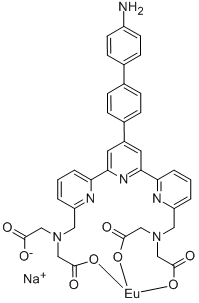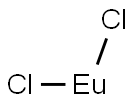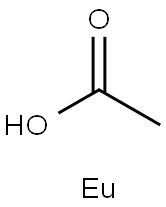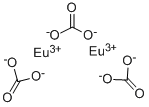EUROPIUM
Synonym(s):EU000200;EU005110;EU006010;Europium
- CAS NO.:7440-53-1
- Empirical Formula: Eu
- Molecular Weight: 151.96
- MDL number: MFCD00010992
- EINECS: 231-161-7
- SAFETY DATA SHEET (SDS)
- Update Date: 2024-12-18 14:15:30

What is EUROPIUM?
Chemical properties
grey ingots
Physical properties
Europium is one of the most rare of the rare-earths. Its abundance on Earth is only 1.1ppm. It is a soft, shiny, steel-gray metal that is quite ductile and malleable, which means it canbe worked and formed into many shapes. It looks like and feels like the element lead (Pb), butis somewhat heavier. It is the most chemically active of all the rare-earths.
Europium’s melting point is 822°C, its boiling point is 1,529°C, and its density is 5.243g/cm3.
Isotopes
There are a total of 45 isotopes of europium. Two are considered stable andaccount for 100% of the europium found on Earth: Eu-151 (47.81%) and Eu-153(52.19%). All the other 53 isotopes are radioactive and artificially produced, primarily through electron capture.
Origin of Name
Named for the continent of Europe.
Occurrence
Europium is the 13th most abundant of all the rare-earths and the 55th most abundantelement on Earth. More europium exists on Earth than all the gold and silver deposits. Likemany other rare-earths, europium is found in deposits of monazite, bastnasite, cerite, andallanite ores located in the river sands of India and Brazil and in the beach sand of Florida.It has proven difficult to separate europium from other rare-earths. Today, the ion-exchange process is used to extract europium from the other rare-earths found in monazite sand(ore).
History
In 1890 Boisbaudran obtained basic fractions from samarium-gadolinium concentrates that had spark spectral lines not accounted for by samarium or gadolinium. These lines subsequently have been shown to belong to europium. The discovery of Europium is generally credited to Demarcay, who separated the rare earth in reasonably pure form in 1901. The pure metal was not isolated until recent years. Europium is now prepared by mixing Eu2O3 with a 10% excess of lanthanum metal and heating the mixture in a tantalum crucible under high vacuum. The element is collected as a silvery-white metallic deposit on the walls of the crucible. As with other rare-earth metals, except for lanthanum, europium ignites in air at about 150 to 180°C. Europium is about as hard as lead and is quite ductile. It is the most reactive of the rare-earth metals, quickly oxidizing in air. It resembles calcium in its reaction with water. Bastnasite and monazite are the principal ores containing europium. Europium has been identified spectroscopically in the sun and certain stars. Europium isotopes are good neutron absorbers and are being studied for use in nuclear control applications. Europium oxide is now widely used as a phosphor activator and europium-activated yttrium vanadate is in commercial use as the red phosphor in color TV tubes. Europiumdoped plastic has been used as a laser material. With the development of ion-exchange techniques and special processes, the cost of the metal has been greatly reduced in recent years. Natural europium contains two stable isotopes. Thirty-five other radioactive isotopes and isomers are known. Europium is one of the rarest and most costly of the rare-earth metals. It is priced at about $60/g (99.9% pure).
Characteristics
Pure europium will slowly oxidize in air at room temperature and will produce hydrogenwhen placed in water. It will ignite spontaneously if the air temperature is over 150°C. Insome ways europium resembles the elements calcium, strontium, and barium found in group2 of the periodic table.
The Uses of EUROPIUM
There are only a few commercial uses for europium. Europium oxide, (Eu2O3), a compoundof europium, is added to infra-sensitive phosphors to enhance the red colors on TVand computer-monitor picture tubes. It is also added to fluorescent light tubes to increasetheir efficiency, as well as to some materials to make lasers. Since it is a good neutron absorber,it is part of nuclear reactor control rods. Europium is an additive to the glue used on postagestamps, thus making it possible for the electronic sorting machines in U.S. postal offices to“read” the stamps.
The Uses of EUROPIUM
Neutron absorber in nuclear control, color-TV phosphors to activate yttrium, phosphors in postagestamp glues to permit electronic recognition of firstclass mail.
Definition
Atomic number 63, one of the lanthanide or rare-earth elements of the cerium subgroup, aw 151.96, valences of 2, 3; two stable isotopes.
Definition
A silvery element of the lanthanoid series of metals. It occurs in association with other lanthanoids. Its main use is in a mixture of europium and yttrium oxides widely employed as the red phosphor in television screens. The metal is used in some superconducting alloys. Symbol: Eu; m.p. 822°C; b.p. 1597°C; r.d. 5.23 (25°C); p.n. 63; r.a.m. 151.965.
Definition
europium: Symbol Eu. A soft silverymetallic element belonging to thelanthanoids; a.n. 63; r.a.m. 151.96;r.d. 5.245 (20°C); m.p. 822°C; b.p.1597°C. It occurs in small quantitiesin bastanite and monazite. Two stableisotopes occur naturally: europium–151 and europium–153, bothof which are neutron absorbers. Experimentaleuropium alloys havebeen tried for nuclear-reactor partsbut until recently the metal has notbeen available in sufficient quantities.It is widely used in the form ofthe oxide in phosphors for televisionscreens. It was discovered by SirWilliam Crookes in 1889.
Hazard
Highly reactive, may ignite spontaneously in powder form.
Hazard
Europium is very reactive and, in powder form, may burst into flames spontaneously atroom temperature. Most of the salts of europium are toxic when inhaled or ingested.
Properties of EUROPIUM
| Melting point: | 822 °C (lit.) |
| Boiling point: | 1527 °C (lit.) |
| Density | 5.24 g/mL at 25 °C (lit.) |
| solubility | reacts with H2O |
| form | ingot |
| color | Silver/gray |
| Specific Gravity | 5.24 |
| Resistivity | 81 μΩ-cm, 20°C |
| Water Solubility | Reacts with water. |
| Sensitive | Air & Moisture Sensitive |
| Merck | 13,3937 |
| Exposure limits | ACGIH: TWA 2 ppm; STEL 4 ppm OSHA: TWA 2 ppm(5 mg/m3) NIOSH: IDLH 25 ppm; TWA 2 ppm(5 mg/m3); STEL 4 ppm(10 mg/m3) |
| InChI | InChI=1S/Eu |
| CAS DataBase Reference | 7440-53-1(CAS DataBase Reference) |
| EPA Substance Registry System | Europium (7440-53-1) |
Safety information for EUROPIUM
| Signal word | Danger |
| Pictogram(s) |
 Flame Flammables GHS02 |
| GHS Hazard Statements |
H250:Pyrophoric liquids; Pyrorophoric solids |
| Precautionary Statement Codes |
P222:Do not allow contact with air. P231:Handle under inert gas. P422:Store contents under … |
Computed Descriptors for EUROPIUM
| InChIKey | OGPBJKLSAFTDLK-UHFFFAOYSA-N |
| SMILES | [Eu] |
New Products
(S)-3-Aminobutanenitrile hydrochloride 4-Methylphenylacetic acid N-Boc-D-alaninol N-BOC-D/L-ALANINOL Tert-butyl bis(2-chloroethyl)carbamate 3-Morpholino-1-(4-nitrophenyl)-5,6-dihydropyridin- 2(1H)-one Furan-2,5-Dicarboxylic Acid Tropic acid 1-Bromo-3,5-Di-Tert-Butylbenzene S-2-CHLORO PROPIONIC ACID ETHYL ISOCYANOACETATE 2-Bromo-1,3-Bis(Dimethylamino)Trimethinium Hexafluorophosphate 4-IODO BENZOIC ACID 3-NITRO-2-METHYL ANILINE 1-(2,4-DICHLOROPHENYL) ETHANAMINE (2-Hydroxyphenyl)acetonitrile 4-Bromopyrazole 2-(Cyanocyclohexyl)acetic acid 4-methoxy-3,5-dinitropyridine 1-(4-(aminomethyl)benzyl)urea hydrochloride 2-aminopropyl benzoate hydrochloride diethyl 2-(2-((tertbutoxycarbonyl)amino) ethyl)malonate tert-butyl 4- (ureidomethyl)benzylcarbamate Ethyl-2-chloro((4-methoxyphenyl)hydrazono)acetateRelated products of tetrahydrofuran








You may like
-
 Europium ingot CAS 7440-53-1View Details
Europium ingot CAS 7440-53-1View Details
7440-53-1 -
 Europium ingot CAS 7440-53-1View Details
Europium ingot CAS 7440-53-1View Details
7440-53-1 -
 Europium foil, 0.25mm (0.01 in.) thick CAS 7440-53-1View Details
Europium foil, 0.25mm (0.01 in.) thick CAS 7440-53-1View Details
7440-53-1 -
 Europium foil, 0.25mm (0.01 in.) thick CAS 7440-53-1View Details
Europium foil, 0.25mm (0.01 in.) thick CAS 7440-53-1View Details
7440-53-1 -
 Europium, ingot, 99.9% CAS 7440-53-1View Details
Europium, ingot, 99.9% CAS 7440-53-1View Details
7440-53-1 -
 Europium foil, 0.8 mm thick, 99.9% CAS 7440-53-1View Details
Europium foil, 0.8 mm thick, 99.9% CAS 7440-53-1View Details
7440-53-1 -
 Europium foil, 1.0mm (0.04in) thick, 99.9% CAS 7440-53-1View Details
Europium foil, 1.0mm (0.04in) thick, 99.9% CAS 7440-53-1View Details
7440-53-1 -
 Europium ICP standard CASView Details
Europium ICP standard CASView Details